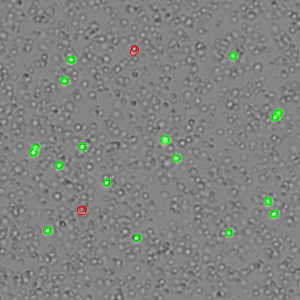Quantifying and qualifying the viability of primary cells can be difficult via conventional cell counting methodologies (hemocytometry, slide-based microscopy, etc.). Primary cells are cells that have been harvested directly from living tissues and isolated in vitro. They are not modified like artificially preserved cell lines, which makes them a better representation of the cells’ in vivo state and normal physiology.
Although primary cell samples have a higher degree of biological relevance, they often retain a heterogeneous collection of different cell types. These heterogeneities and cellular debris are the main factors complicating primary cell counting.
In this post, DeNovix will explore primary cell counting with a focus on peripheral blood mononuclear cells (PBMCs).
What are PBMCs?
Peripheral blood cells are the cellular components of blood (erythrocytes, platelets, etc.) while PBMCs are any of these that comprise a round nucleus, such as lymphocytes. They are a typical primary cell source in biological and life science research with particular prevalence in the field of immunology. Accurate cell counting of PBMCs is crucial in assays such as cell proliferation or cytotoxicity.
Difficulties in PBMC Cell Counting
Alongside the above challenges of primary cell counting, PBMCs can be difficult to distinguish from red blood cells (erythrocytes) by the naked eye. With a hemocytometer and conventional light-based microscope, PBMCs will appear faint and their characteristic biconcave shape closely resembles that of erythrocytes. Therefore, manual cell counting of PBMCs demands experienced personnel to ensure accurate results.
Automated PBMC Cell Counting
The CellDrop™ Automated Cell Counter is a novel concept for primary cell counting and viability testing and is equipped with dual fluorescence and brightfield optics, and proprietary DirectPipette™ technology. This eliminates disposable slides from the workflow and streamlines the procedure for PBMC cell counting.
A simple mix-and-measure, dual fluorescence assay provides robust and reproducible identification of PBMCs in a background of RBCs. Acridine orange stains nucleated PBMCs, causing live cells to fluorescence green, while propidium iodide permeates the compromised membranes of dead cells and causes them to fluoresce red. As red blood cells are unstained, they do not fluoresce.
After samples have been centrifuged, vortexed, and mixed with the DeNovix AO/PI Viability Assay, they are pipetted directly into the CellDrop sample chamber. Pre-programed or user-defined protocols are used to set image and counting parameters. Software algorithms automatically identify and count cell types in seconds, removing the subjectivity and inaccuracies associated with manual counting methods.
- Technical Note 187 Counting PBMCs with CellDrop
- Technical Note 209 Counting PBMCs in Whole Blood
- Cell Counting with Acridine Orange and Propidium Iodide (AO/PI)
Denovix AO/PI assays are routinely used fluorophores for automated cell counting of PBMCs. The CellDrop is compatible with a range of common assays and reagents used in cell counting. If you would like to learn more, simply contact a member of the Denovix team today.





